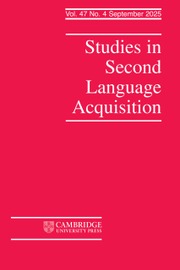Crossref Citations
This article has been cited by the following publications. This list is generated based on data provided by
Crossref.
Wakabayashi, Shigenori
2002.
The acquisition of non-null subjects in English: a minimalist account.
Second Language Research,
Vol. 18,
Issue. 1,
p.
28.
Chaudron, Craig
2003.
The Handbook of Second Language Acquisition.
p.
762.
Norris, John
and
Ortega, Lourdes
2003.
The Handbook of Second Language Acquisition.
p.
716.
Oshita, Hiroyuki
2004.
Is there anything there when there is not there? Null expletives and second language data.
Second Language Research,
Vol. 20,
Issue. 2,
p.
95.
Tsimpli, Ianthi Maria
2004.
Iterprétabilité des traits et acquisition des langues maternelle et seconde : clitiques et déterminants en grec.
Acquisition et interaction en langue étrangère,
p.
87.
Park, Hyeson
2004.
A minimalist approach to null subjects and objects in second language acquisition.
Second Language Research,
Vol. 20,
Issue. 1,
p.
1.
Hawkins, R.
and
Lozano, C.
2006.
Encyclopedia of Language & Linguistics.
p.
67.
Liu, Dilin
2008.
Intransitive or Object Deleting?.
Journal of English Linguistics,
Vol. 36,
Issue. 4,
p.
289.
Zyzik, Eve C.
2008.
Null objects in second language acquisition: grammatical vs. performance models.
Second Language Research,
Vol. 24,
Issue. 1,
p.
65.
Liu, Dilin
2008.
Adequate language description in L2 research/teaching: the case of pro‐drop language speakers learning L2 English.
International Journal of Applied Linguistics,
Vol. 18,
Issue. 3,
p.
274.
Jiang, Lin
2009.
A referential/quantified asymmetry in the second language acquisition of English reflexives by Chinese-speaking learners.
Second Language Research,
Vol. 25,
Issue. 4,
p.
469.
Cheung, Him
Yap, Foong-Ha
and
Yip, Virginia
2012.
Oxford Handbook of Chinese Psychology.
p.
123.
GRÜTER, THERES
and
CRAGO, MARTHA
2012.
Object clitics and their omission in child L2 French: The contributions of processing limitations and L1 transfer.
Bilingualism: Language and Cognition,
Vol. 15,
Issue. 3,
p.
531.
Hawkins, Roger
2012.
Knowledge of English verb phrase ellipsis by speakers of Arabic and Chinese.
Linguistic Approaches to Bilingualism,
Vol. 2,
Issue. 4,
p.
404.
Cuza, Alejandro
2013.
Crosslinguistic influence at the syntax proper: Interrogative subject–verb inversion in heritage Spanish.
International Journal of Bilingualism,
Vol. 17,
Issue. 1,
p.
71.
Cuza, Alejandro
Pérez-Leroux, Ana Teresa
and
Sánchez, Liliana
2013.
THE ROLE OF SEMANTIC TRANSFER IN CLITIC DROP AMONG SIMULTANEOUS AND SEQUENTIAL CHINESE-SPANISH BILINGUALS.
Studies in Second Language Acquisition,
Vol. 35,
Issue. 1,
p.
93.
황세희
2015.
Korean EFL Learners’ Object-drop and Topic-prominence.
Korean Journal of English Language and Linguistics,
Vol. 15,
Issue. 2,
p.
327.
Cuza, Alejandro
and
Frank, Joshua
2015.
On the role of experience and age-related effects: Evidence from the Spanish CP.
Second Language Research,
Vol. 31,
Issue. 1,
p.
3.
García Mayo, María del Pilar
and
Slabakova, Roumyana
2015.
Object drop in L3 acquisition.
International Journal of Bilingualism,
Vol. 19,
Issue. 5,
p.
483.
White, Lydia
2016.
Language Acquisition Beyond Parameters.
Vol. 51,
Issue. ,
p.
17.

